
PTSD Treatments Are Falling Short for Many Patients
Therapy and medication can help people recover from trauma, but many struggle to access the care they need. Post-traumatic stress disorder (PTSD) profoundly affects individuals, often causing them to withdraw and become reluctant to discuss their experiences. Despite the availability of several treatments, many patients find them inaccessible or ineffective.
The Challenge of Treating PTSD
💔 Isolation and Withdrawal
PTSD often leads individuals to isolate themselves, making it difficult for them to engage in treatments that require openness and trust. This condition’s inherent nature complicates the effectiveness of traditional therapies.
💸 Expensive and Distressing Treatments
While psychotherapy and medication can be effective for many, they come with challenges. Treatments can be costly and distressing, causing some patients to discontinue therapy before completing it.
🔬 Need for Better Solutions
“The field has acknowledged for years that we need to do better for our patients,” said Dr. Jerry Rosenbaum, a professor of psychiatry at Harvard Medical School. This sentiment was echoed during a recent FDA advisory panel meeting discussing the approval of new treatments.
Exploring New Treatment Options
🌿 MDMA-Assisted Therapy
One promising new treatment combines the psychoactive drug MDMA with talk therapy. Despite showing potential, the expert panel voted against endorsing MDMA-assisted therapy due to concerns about safety and clinical trial issues.
🧠 Call for Innovation
Even with the rejection of MDMA-assisted therapy, experts emphasized the urgent need for innovative treatments for PTSD, which can cause severe symptoms like intrusive thoughts, flashbacks, and nightmares.
The Prevalence of PTSD
📊 Statistics
Approximately six percent of the American population will develop PTSD at some point in their lives. Unfortunately, only a fraction of these individuals recover, highlighting the need for improved diagnosis and treatment methods.
🔍 Diagnosis Challenges
Diagnosing PTSD can be challenging. The gold standard is the Clinician Administered PTSD Scale (CAPS-5), which involves detailed assessments of symptoms. However, many people with PTSD remain undiagnosed, partly because they do not recognize the symptoms or due to the public perception of PTSD being closely tied to military combat.
Existing Treatments for PTSD
🗣️ Psychotherapy
Psychotherapy is the primary treatment for PTSD. Prolonged exposure therapy and cognitive processing therapy are two common approaches. These therapies help patients confront their fears and understand how the disorder affects their perception of themselves and the world.
🌀 Other Therapies
Other effective treatments include eye movement desensitization and reprocessing (EMDR) therapy, which activates both sides of the brain as patients recall traumatic events, and interpersonal psychotherapy, which focuses on the impact of trauma on relationships.
Limitations of Current Treatments
🚪 Treatment Dropout
Despite their effectiveness, many patients do not respond to these therapies, and a significant number drop out early due to the distressing nature of revisiting traumatic memories. Clinical trials show an average dropout rate of nearly 20 percent, which may be higher in practice.
💸 Barriers to Access
The cost of therapy, insurance coverage issues, and a shortage of mental health providers create additional barriers to treatment. These factors contribute to the high percentage of individuals who continue to meet PTSD diagnostic criteria even after treatment.

Medication for PTSD
💊 Approved Medications
The FDA has approved two medications for PTSD: sertraline and paroxetine, both selective serotonin reuptake inhibitors (SSRIs). These medications help manage symptoms but do not address the underlying causes of PTSD.
⚕️ Off-Label Medications
Clinicians may also prescribe off-label medications like prazosin, a blood pressure medication that can alleviate nightmares associated with PTSD. However, these medications only address specific symptoms rather than the disorder as a whole.
The Need for Experimental Treatments
🌐 Emerging Therapies
In recent years, experimental treatments such as MDMA-assisted psychotherapy, virtual reality therapy, and neurofeedback have gained traction. These approaches offer new hope for patients who do not respond to traditional therapies.
🧩 Future Directions
Experts agree that more effective treatment options are essential. The development of new therapies and better access to existing treatments can significantly improve the lives of those suffering from PTSD.
Conclusion
📝 Summary
While current treatments for PTSD, including psychotherapy and medication, help many patients, they fall short for a significant portion of the population. The high cost of treatment, the distress it can cause, and the barriers to accessing care highlight the need for innovation.
🚀 Moving Forward
As the medical community continues to explore and validate new treatment options, the hope is to offer more effective solutions for PTSD. This ongoing effort is crucial in providing better care and improving the quality of life for those affected by this debilitating disorder.




















Good Job
Woaa